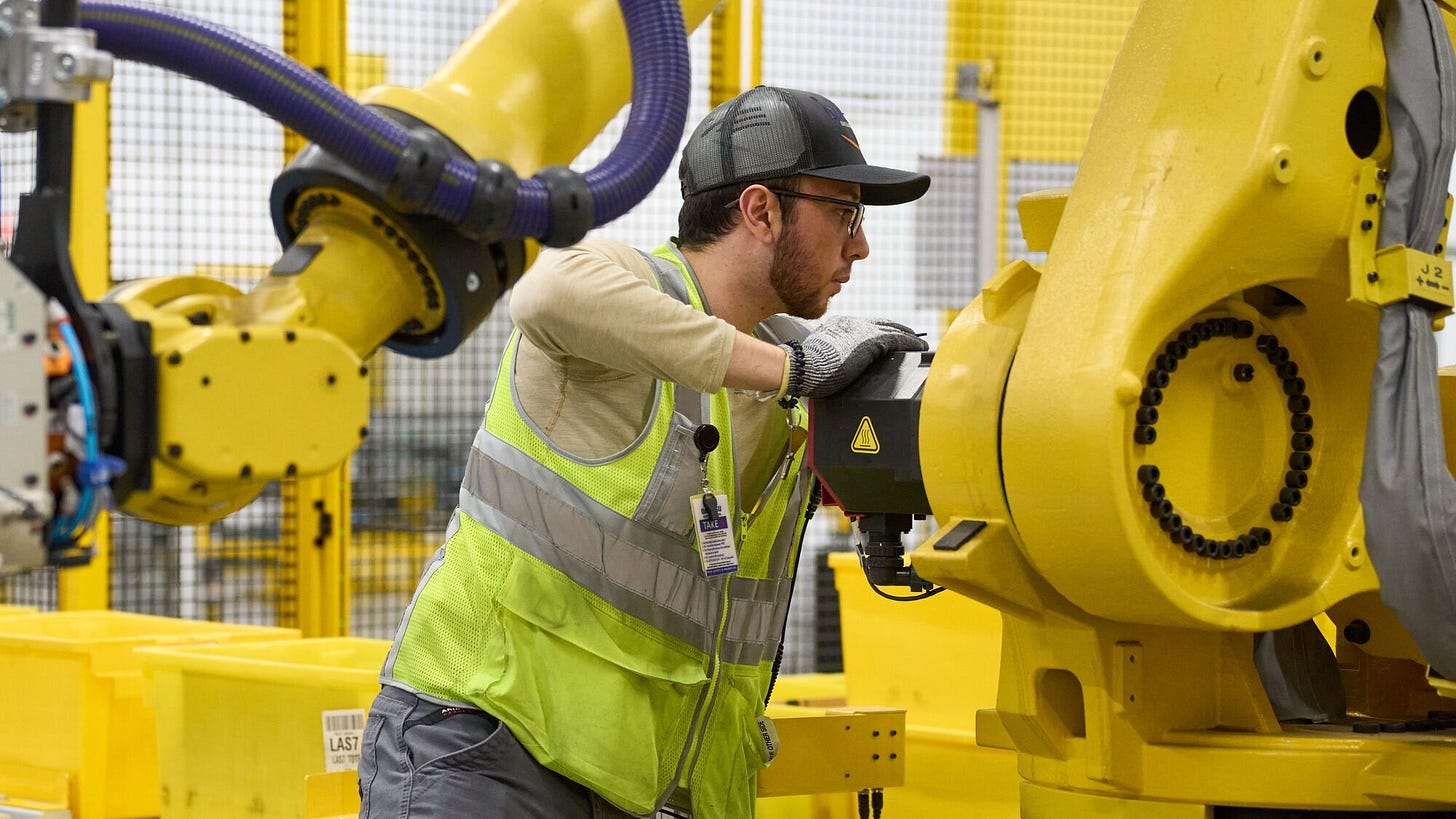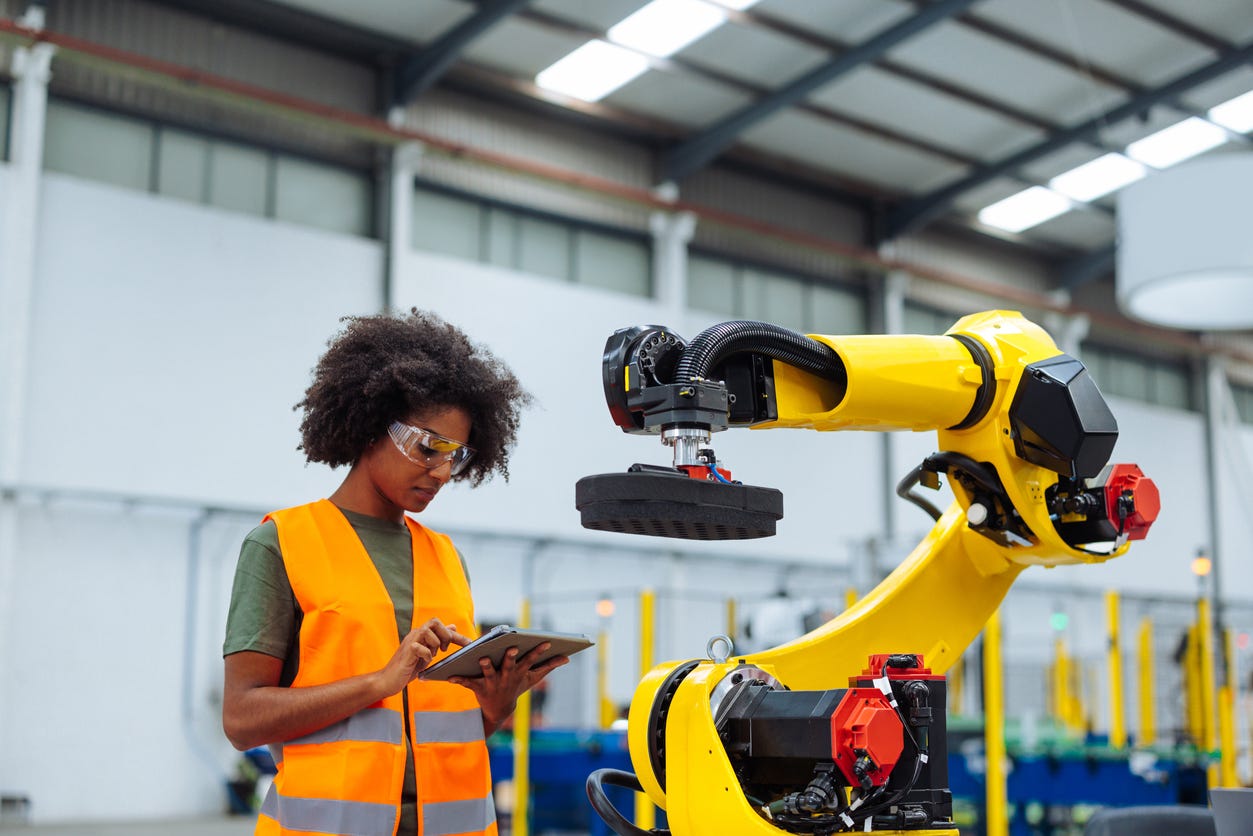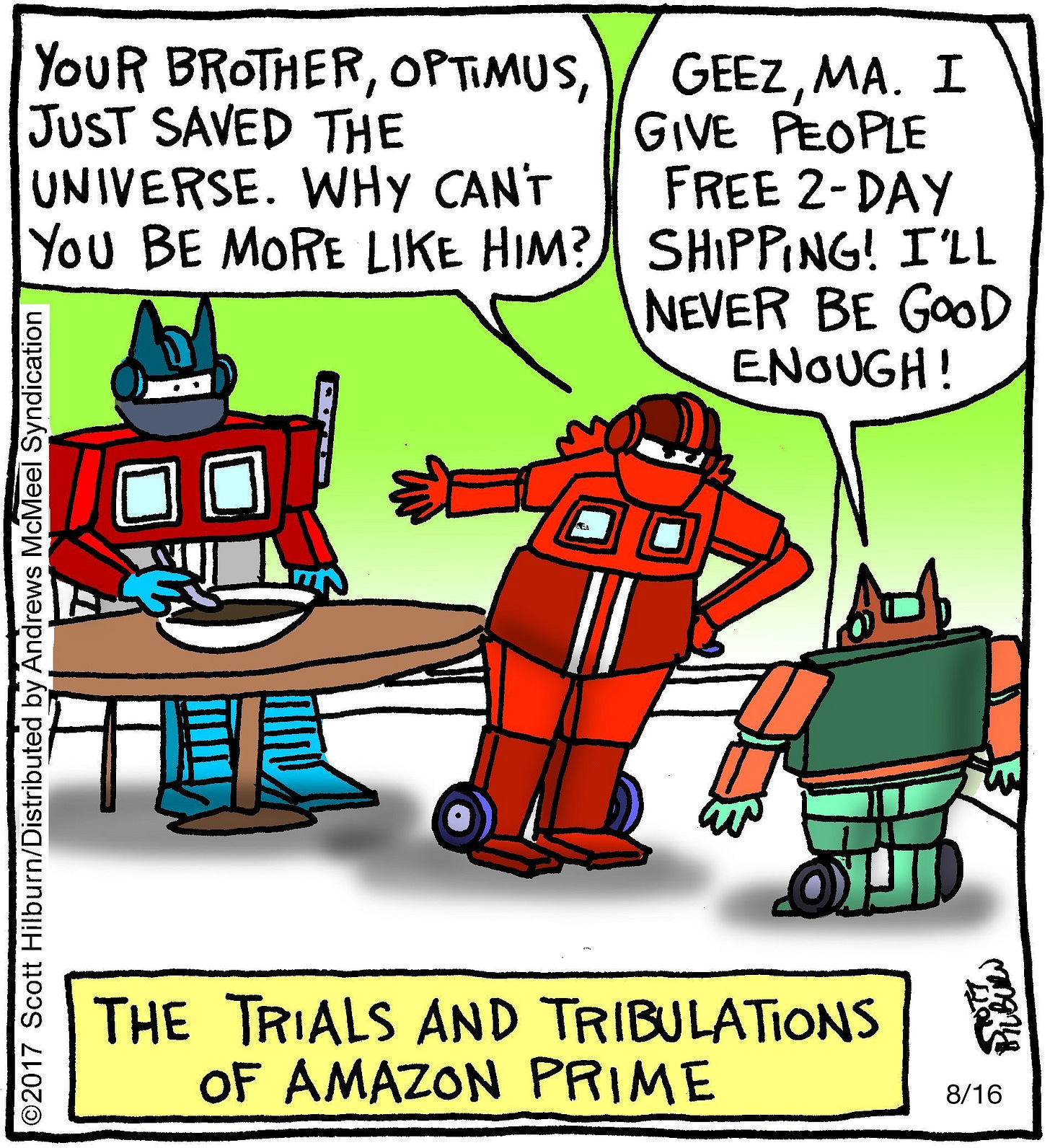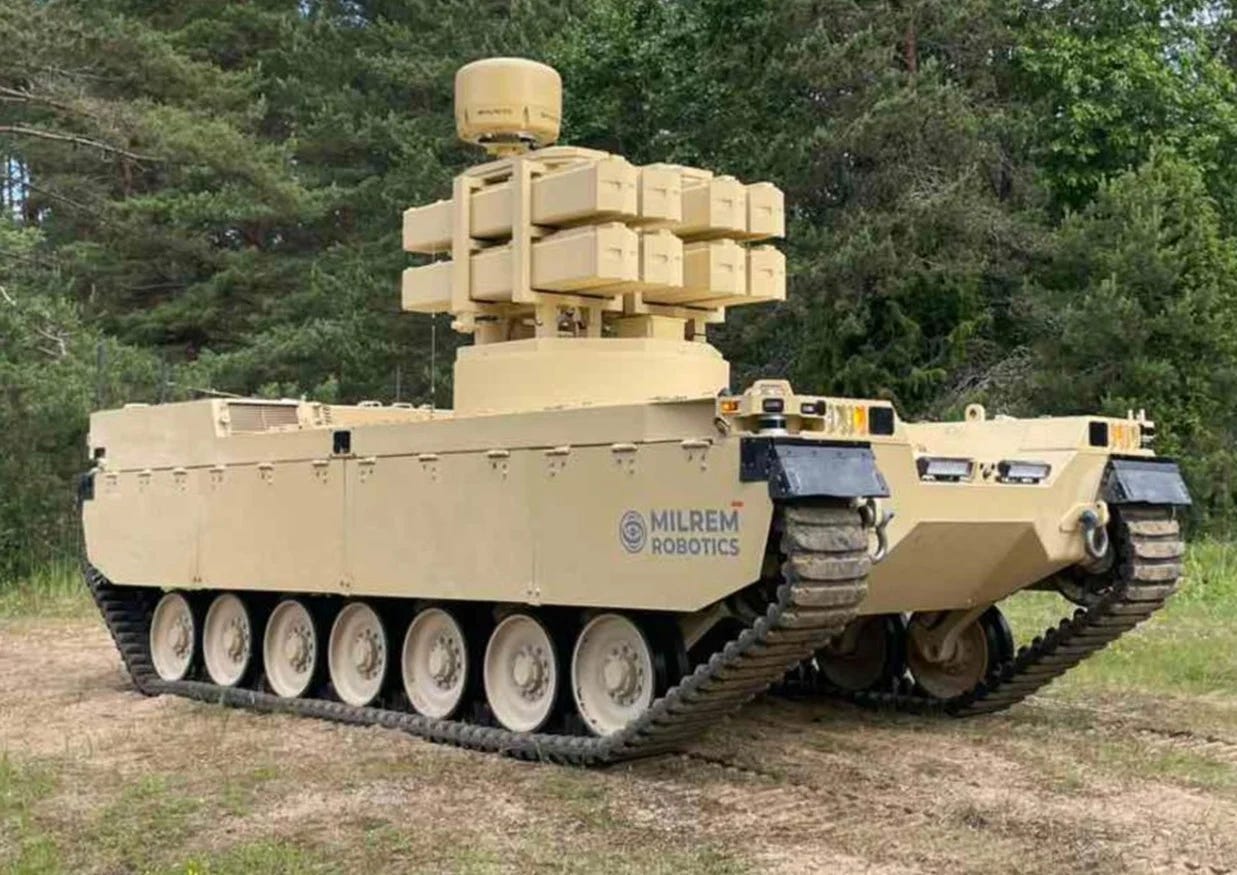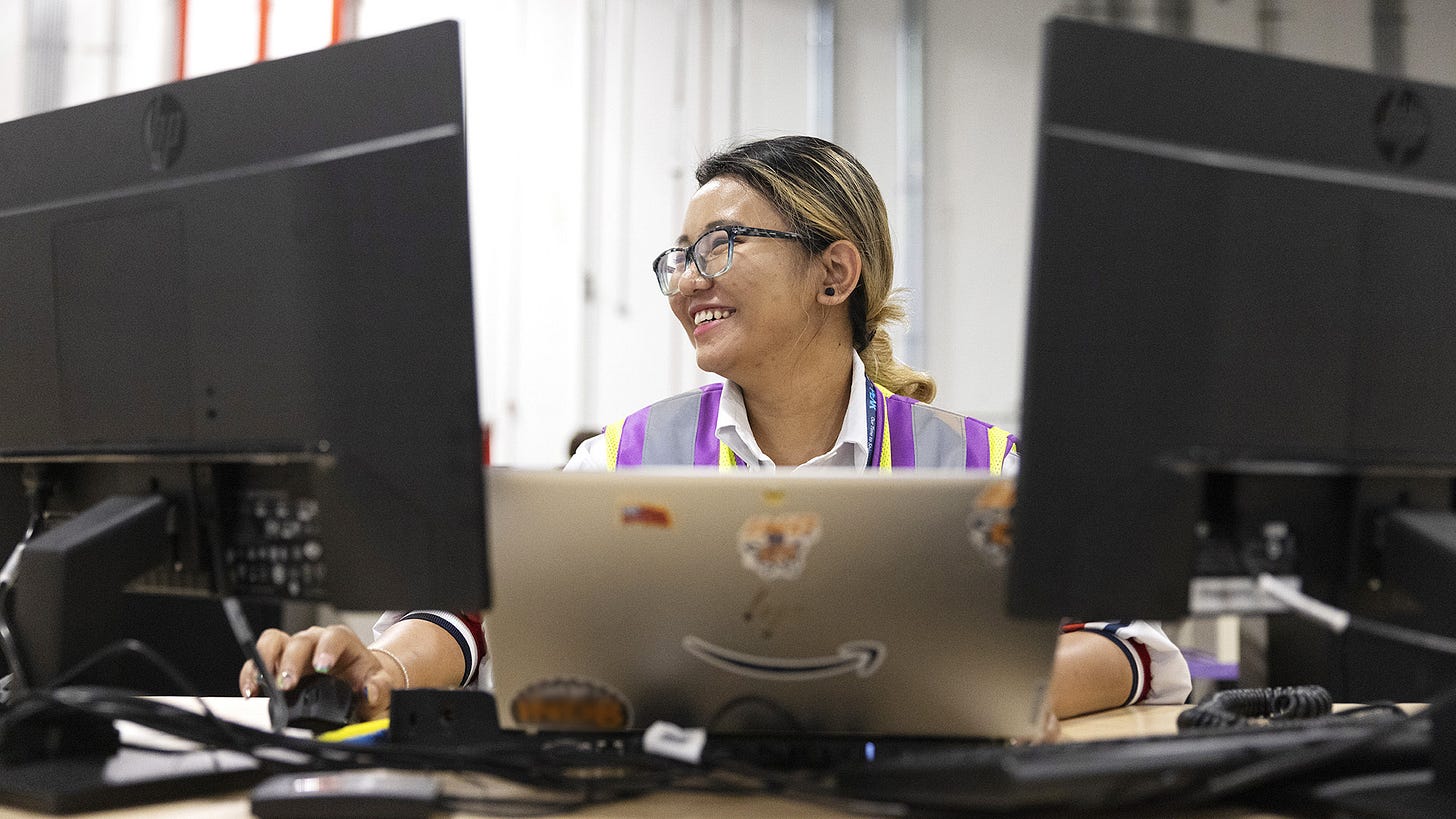Amazon’s Million-Bot March
What Amazon’s robot milestone means for the future of labor, logistics, and the role of human workers
“Automation does not need to be our enemy. I think machines can make life easier for men.” – John F. Kennedy
Amazon’s announcement that it has now deployed over 1 million robots in its operations is more than just a headline — it marks a turning point in how we think about automation, labor, and the future of work. While the robotics industry might celebrate this as a validation of decades of engineering progress, for workers, policymakers, and society at large, this number invites both optimism and concern.
From Hype to Scale
For years, warehouse robots were largely experimental tech—prototypes and pilots promising efficiency and innovation, yet not widely deployed. Amazon’s milestone of 1 million deployed robots (approaching parity with its ~1.5 million human workforce) transforms that promise into reality. These aren’t futuristic humanoids, but highly specialized systems—wheeled bots like Proteus, arms like Sparrow, heavy‑lift units like Hercules—as well as advanced AI systems like Vulcan and DeepFleet coordinating their actions.
This extensive deployment—the robots now assist roughly 75 % of Amazon’s global deliveries—demonstrates that automation at industrial scale isn’t speculative; it’s already reshaping operations globally. With deployments across 300+ facilities, often with fewer employees per site than ever before, scale has become the story—robots are a core part of Amazon’s logistics backbone, not a side project.
A Productivity Powerhouse — But at What Cost?
Amazon credits its robots for speeding up fulfillment, reducing errors, and improving safety by removing repetitive, taxing tasks. Robots like Hercules and Sparrow lift heavy payloads or repeatedly sort goods, reducing injury risk and physical strain for human workers. Additionally, systems like DeepFleet optimize fleet movement, cutting travel inefficiencies by about 10 %, which translates into faster delivery and lower costs.
Still, critics highlight a darker side. Average headcount per facility has dropped to just 670—the lowest in 16 years—raising red flags about displaced workers. Meanwhile, Amazon has reduced corporate staffing amid AI-driven efficiencies. Workers are reporting accelerated pace pressures, and some have expressed concern that automation tools are being used as surveillance or productivity keystones. The growing divide between technological capability and equitable work raises important questions about the cost of efficiency.
The Future of Work: Augmentation vs. Replacement
Amazon frames its automation strategy as human‑centric: robots are meant to augment, not replace, workers. The company touts that the adoption of robotics has spurred the need for skilled roles—such as maintenance, engineering, fleet oversight, and AI modeling—with over 700,000 employees trained since 2019.
Independent MIT and Australian studies echo this sentiment—workers who collaborate with automation often report better safety, job satisfaction, and productivity. As one report summarized: “employees who have hands‑on experience with robotics are generally more positive about the impact of automation.”
But the flip side is clear: as technology handles more routine or manual duties, humans must shift toward problem-solving, oversight, and supervisory roles. That transition isn’t automatic—it requires sustained investment in training, career pathways, and policy support. The risk: without such backing, automation could yield fractured labor markets with a growing class of underskilled workers left behind.
Looking Back from 2035
In a decade from now, the 1 million robot milestone may be seen as pivotal—akin to the advent of the Ford assembly line or the smartphone revolution. In 2035, we might reflect on this moment as marking a structural shift: logistics and supply chain functions reshaped by human‑robot collaboration, productivity redefined, and consumer expectations elevated.
But whether that future is broadly shared depends on today’s actions. Will Amazon and similar companies invest in reskilling at scale? Will governments expand safety nets, apprenticeships, and policies for workforce transitions? Or will the benefits concentrate in tech‑heavy pockets?
The next decade must be a test of whether society treats automation as a lever for shared prosperity or simply a method to increase profits. If we’re proactive, the 1 million robot moment will be a turning point in uplifting labor, productivity, and economic resilience. If not, it will symbolize growing economic inequality and labor precarity.
Final Reflection
Amazon’s rollout of 1 million robots is more than an operational benchmark—it’s a defining moment in modern labor history. It blends cutting-edge AI and engineering with real-world human impact. The robotics industry benefits from validation and demand; Amazon reaps efficiency and scale, but the future of work hinges on how society adapts.
In the years to come, this milestone will not just be about machines; it will be judged on opportunities created, jobs redefined, and whether human workers are partners or bystanders in this new era. The millionth robot is merely a signpost. What matters next is how we follow the road behind it.
Robot News Of The Week
Galbot picks up $153M to commercialize G1 semi-humanoid
Beijing-based robotics startup Galbot has raised $153 million in new funding, bringing its total to $335 million in just two years. The company, founded in 2023, focuses on retail automation with its semi-humanoid G1 robot, which uses wheels and dual arms to handle over 5,000 types of goods. Designed for tasks like inventory and delivery, the G1 can be deployed in a store within a day and is already operating in nearly 10 Beijing locations, with plans to expand to 100 nationwide by year’s end.
Galbot’s technology is powered by its own vision-language-action (VLA) models that allow the G1 to generalize tasks with minimal setup, adapt to cluttered environments, and understand natural language. The company uses NVIDIA Isaac Sim for training and claims zero-shot performance with synthetic data.
The funding round was led by CATL and Puquan Capital, with support from China Development Bank and others. Galbot also recently launched a joint venture with Bosch’s Boyuan Capital to expand its embodied AI applications into industrial manufacturing.
Pittsburgh Robotics Network launches Deep Tech Institute for Leadership and Innovation
The Pittsburgh Robotics Network has launched the Deep Tech Institute for Leadership and Innovation (DTI), a new initiative designed to strengthen the robotics, AI, and advanced technology workforce by focusing on talent development.
DTI offers two tracks: Emerging Leaders, launching in Summer 2025, targets early-career engineers and interns with real-world exposure through site visits and industry sessions. In 2026, Senior Leaders programming will debut in partnership with Cybernetix Ventures, providing leadership training for current professionals to help them align technical innovation with business strategy.
PRN says DTI fills a key gap by preparing talent not just to innovate, but to lead, scale companies, and influence policy. Applications for the pilot Emerging Leaders program are open until July 10.
Europe builds robotic vehicle to hunt tanks
SignalGeneriX has successfully integrated its RFHunter direction-finding system into a new European robotic combat platform as part of the EU-funded MARSEUS defense program. Installed on an MBDA turret armed with AKERON LP missiles and mounted on Milrem Robotics' Type-X unmanned ground vehicle, the system enables beyond-line-of-sight anti-tank operations while delivering real-time electromagnetic situational awareness.
RFHunter detects radio frequency signals on the battlefield, helping operators identify and engage threats without visual contact. Paired with the AKERON’s 20 km range and the Type-X’s mobility, the setup enhances precision targeting and survivability in contested zones.
The integration is a milestone in European defense collaboration, supported by the Ministries of Defence of France, Sweden, Belgium, and Cyprus. Operational trials of the upgraded platform are expected later this year.
Robot Research In The News
New system allows acoustic robots to co-operatively transport objects
Researchers at University College London have developed a new system that allows teams of robots to cooperatively transport objects in mid-air using ultrasonic sound waves, inspired by how ants carry items together. Unlike traditional robots that move objects by physical contact, this system uses phased ultrasonic transducers to create acoustic pressure fields strong enough to levitate and move small objects without touching them.
The system supports both independent and coordinated swarm transport, mimicking insect behavior to improve efficiency. In tests, the robots successfully transported objects with high precision, using real-time synchronization and motion tracking.
This approach could open up new possibilities for contactless material handling, micro-assembly, and even biomedical applications, especially in environments too small or risky for human access.
A new ‘eye’ may radically change how robots see
A new vision system called LENS enables a hexapod robot to recognize its surroundings using less energy and memory than a single photo on a smartphone, researchers report in Science Robotics. It uses just 10% of the power required by conventional location systems.
Developed with the Speck sensor and chip from SynSense, LENS mimics the human eye, detecting only changes in brightness rather than capturing constant video like traditional cameras. This drastically reduces data and power consumption, which is crucial for drones, microrobots, and robots in space or underwater.
The system combines a neuromorphic sensor, a low-power processor, and a tiny AI model that learns to recognize places by analyzing edges and key environmental features, not full images.
Researchers say this could revolutionize how small, mobile robots navigate with minimal battery drain.
Robot Workforce Story Of The Week
9 free skills training programs that help Amazon employees land higher-paying roles
Amazon’s workforce development programs have helped more than 700,000 employees worldwide gain new skills and advance into high-demand careers. Since 2019, over 425,000 U.S. workers have participated in initiatives ranging from robotics and cloud computing to GED completion and English language learning. Programs like Career Choice, AWS Grow Our Own Talent, and the Mechatronics and Robotics Apprenticeship offer prepaid tuition, flexible schedules, and clear job pathways. These efforts, driven by employee feedback, aim to transform lives by turning warehouse workers into technicians, engineers, and designers. With options like Machine Learning University and UX Design Apprenticeships, Amazon is redefining career mobility, creating opportunities in both tech and non-tech fields. From building satellites to managing data centers, the company’s investment in its people reflects a broader commitment to shaping the future workforce.
Robot Video Of The Week
Two robots had to be stretchered off after collapsing during the world’s first fully autonomous humanoid football match in Beijing. The event featured four university teams competing in 3-on-3 games with no human control, using robots equipped with visual sensors and AI algorithms to play independently.
While the robots could identify the ball and stand after falling, several failed to recover and had to be carried off. Others struggled with basic movements like kicking, leading to slow-motion collisions and limited action on the field.
The match served as a preview for China’s upcoming World Humanoid Robot Games and is part of a broader effort to test and advance humanoid robotics through real-world sports. Booster Robotics supplied the hardware, while each university developed its own AI systems.
Tsinghua University’s team won the final match 5–3 over China Agricultural University. Organizers hope such events will accelerate AI development and build public trust in humanoid robots through safe human-robot interactions in the future.
Source: The Independent
Upcoming Robot Events
Aug. 17-21 Intl. Conference on Automation Science & Engineering (Anaheim, CA)
Aug. 25-29 IEEE RO-MAN (Eindhoven, Netherlands)
Sept. 3-5 ARM Institute Member Meetings (Pittsburgh, PA)
Sept. 15-17 ROSCon UK (Edinburgh)
Sept. 23 Humanoid Robot Forum (Seattle, WA)
Sept. 27-30 IEEE Conference on Robot Learning (Seoul, KR)
Sept. 30-Oct. 2 IEEE International Conference on Humanoid Robots (Seoul, KR)
Oct. 6-10 Intl. Conference on Advanced Manufacturing (Las Vegas, NV)
Oct. 15-16 RoboBusiness (Santa Clara, CA)
Oct. 19-25 IEEE IROS (Hangzhou, China)
Oct. 27-29 ROSCon (Singapore)
Nov. 3-5 Intl. Robot Safety Conference (Houston, TX)
Dec. 11-12 Humanoid Summit (Silicon Valley TBA)






